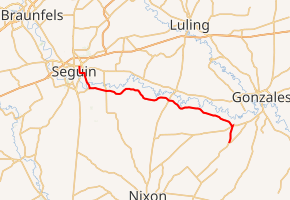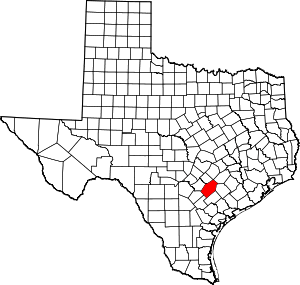Belmont, Texas
Belmont is an unincorporated area in extreme western Gonzales County, defined by an intersection at Texas State Highway 80 and FM 466,[3] towards the limits of the northern and western county line; bordered by the significant 1800s land grants of Eliza Dewitt, Ira Nash (Nash Creek), Samuel Robbins and Thomas Decrew.[4][5] It is served by the Belmont Volunteer Fire Department.[6][7][8]
Belmont | |
|---|---|
Unincorporated Area | |
| Government | |
| • Type | De facto |
| • Body | Fire authority and community services |
| • Fire | Belmont Volunteer Fire Department |
| • Elections | Belmont Community Center[1] |
| • County | Gonzales County |
| Population (2016) | |
| • Total | 36 employed[2] |
| Location | North of Leesville, Texas |
| Website | Belmont VFD |
| |
|---|---|

| |
| Route information | |
| Length | 34.392 mi (55.349 km) |
| Existed | July 9, 1945–present |
| Major junctions | |
| West end | |
| East end | |
| Location | |
| Counties | Guadalupe, Gonzales County |
| Highway system | |
In 2016, Belmont had one construction operation, one wholesale trade operation, two retail trade services, one finance-and-insurance service and one accommodation-and-food service. All sectors reported 36 paid employees during this time, with a first-quarter payroll aggregating to $209,000 and total annual payroll of $816,000.[2]
The area directly connects to the county seats of Seguin and Gonzales through Capote Road (FM 466), as well as served by the bridges and infrastructure of the nearby Guadalupe River.
Belmont shares a part of the history of the Old West as it's featured in The Ballad of Gregorio Cortez, and in the realities of the manhunt of Gregorio Cortez in the historical Battle of Belmont.
Services
Lake Gonzales
Lake Gonzales is a reservoir on the Guadalupe River 4 miles (6 km) southeast of the town of Belmont in Gonzales County, Texas. The reservoir was formed in 1931 by the construction of a dam to provide hydroelectric power to the area. Management of the dam and lake was assume by the Guadalupe-Blanco River Authority on May 1, 1963. Lake Gonzales also serves as a venue for outdoor recreation, including fishing, boating, swimming, camping and picnicking, and is maintained at a constant level year round.
Lake Gonzales is also known locally as H-4 Reservoir or Guadalupe Reservoir H-4.Capote Road
The road begins at an intersection with US 90 on the east side of Seguin, crosses US 90 Alt., heading south to cross the Guadalupe River. From there, it goes east, passing through Monthalia. At Cost, it joins SH 97, just south of Gonzales.
Capote Road passes through a rural area that at one time was heavily farmed. In more recent years more of the sandy land has been given over to pastures, and reverted to post oak woodlands, which support a good population of wildlife, including wild turkeys and deer. The Guadalupe River runs more or less parallel a mile or two to the north, much of its bottomlands filled with pecan orchards. Old Baldy and the other Capote Hills rising above the flatlands provided a landmark for travelers in the pioneer days. Wildflower season sees groups of phlox and fields of bluebonnets, rose cups and buttercups, then gaillardia or Indian blankets, and sunflowers and nettles in the summer, sometimes punctuated by clusters of colorful blossoms on prickly pear cactus.Notable people
Martin Beaty
Martin Beaty (October 8, 1784 – June 17, 1856) was a United States Representative from Kentucky. He was born in Abingdon, Virginia. In his life, he worked as an iron furnace operator, a salt manufacturer, a rancher, and a farmer.
Beaty was a member of the Kentucky Senate 1824–1828 and 1832. He served as a Presidential Elector for Henry Clay and John Sergeant in 1832 and William Henry Harrison and Francis Granger in 1836. He was an unsuccessful candidate for election to the Twenty-first Congress in 1828 and to the Twenty-second Congress in 1830 but was elected as an Anti-Jacksonian to the Twenty-third Congress (March 4, 1833 – March 3, 1835). He was an unsuccessful candidate for reelection to the Twenty-fourth Congress in 1834. After leaving Congress, he was a member of the Kentucky House of Representatives, 1848. He died in 1856 in Belmont, Texas where he was buried in Belmont Cemetery.Gregorio Cortez
After escaping, Cortez went to the ranch of Martín and Refugia Robledo near Belmont, Texas. There were seven persons at the Robledo house. Martín and Refugia Robledo, their three sons, Ramón Rodríguez (a boy living with the Robledos) and a visitor, Martín Sandoval. Gonzales County Sheriff Robert M. Glover, a friend of Sheriff Morris, knew where Cortez was hiding, probably from information obtained under duress. This information would have been either provided by Cortez's mother, wife or sister-in-law as they were the only people who knew where Cortez was going.[9]
According to the Texas Court of Criminal Appeals report of facts, on June 15, 1904, at the time Sheriff Morris was killed, Sheriff Glover was in Cuero, DeWitt County, Texas. Glover proceeded with a deputy sheriff of De Witt County to Kennedy, in Karnes County, and there for the first time learned that Cortez was the man who had killed Sheriff Morris. Glover, knowing the rendezvous of Cortez, boarded a train in about twenty minutes after receiving the information that Cortez had done the killing and proceeded as expeditiously as he could to the town of Ottine, in Gonzales County; there secured horses, and accompanied by two deputy sheriffs of Gonzales County, including Deputy Swift, and other parties, went a few miles in the country to the Schnable ranch; and there learned that Cortez was at the home of Martin Roblero. He and his posse went to Roblero's. The posse divided as they approached the house from the north side; Glover and one or more companions going on the east side of the house around to the south side; and the other parties going on the west side around to the south side of the house. According to the Court, some of the testimony tends to show that the sheriff's posse shot first; but the preponderance of the evidence shows that Cortez and Bonafacio fired the first shot. Just before the time that the sheriff's posse arrived at the house, Cortez informed Bonafacio that the Sheriff's troop would be on his tail and asked him what he should do, whether to fight or surrender. Bonafacio would have said, "We will fight". Immediately upon Glover getting around to a point opposite the gallery on the south side of the house, Cortez and Bonafacio Roblero (the Roblero's eldest son), who were in the gallery, allegedly fired upon Glover and killed him. There was a general fusillade of shots on the part of the posse and Cortez and Bonafacio. On the other hand, in his testimony, Cortez asserts that the officers came up and immediately fired upon him; that he returned this fire.[10]
The San-Antonio Express called the Battle of Belmont, as it came to be known, “a tale of bravery unsurpassed on the part of the officers and of desperation on the part of the Mexicans.”. According to this version of the story, Cortez was waiting in ambush, and as Sheriff Glover and Posseman Schnabel approached, he opened fire. Sheriff Glover and Posseman Schnabel were killed[11]
The actual story, according to the scholar Américo Paredes, was less heroic. Just hours after Cortez arrived at the ranch, Glover and his posse had surrounded the house and began to attack. Cortez fired at Glover, who fell dead, and Cortez ran into the brush behind the house to hide. Robledo, his eldest son, and Sandoval were involved in the shooting, while Robledo's wife, his two younger sons and Ramón Rodríguez stayed unarmed inside the house. Shots were exchanged and Ramón Rodríguez was wounded, as well as Robledo’s wife. Another member of the posse shot and killed accidentally his companion, Henry Schnabel. In the end, the posse captured five of the Mexicans, including the two wounded. Cortez, however, escaped.[12]References
- ...Pct. 5 – Belmont Community Center, 14335 Hwy 90A W...
- "ZIP 78604 (Belmont, TX)...ZIP Code Business Statistics: Zip Code Business Patterns by Employment Size Class: 2016". United States Census Bureau Economic Annual Surveys. Retrieved 21 January 2020.
- The intersection of state Highway 80 and FM 466...location just south of Belmont in extreme western Gonzales County...rural intersection near Belmont...in the Belmont area, particularly at that intersection...
- "Library of Congress; Gonzales County, Texas". Retrieved 5 September 2018.
- "Belmont, TX 2019" (PDF). US Department of the Interior, US Geological Survey.
- ...The Belmont Volunteer Fire Department would like to thank everyone who helped in making their annual fundraiser a success. They sold over five hundred plates. They raised over $17,000.00 in the auction and donations. It takes a lot of money to keep and maintain the building, and trucks and the costs of fuel etc. When you look at this Belmont VFD, it is a top notch department in training and the best equipment that it can afford. We are all very proud of their new fire truck...
- ...members of the Belmont Volunteer Fire Department – who are usually the first to arrive at the scene of accidents...Richard Goss with the Belmont VFD...
- ...Belmont VFD fundraiser coming up...
- Paredes 2016, p. ??
- Cortez v. State, 83 S.W. 812 (Tex. Crim. App. 1904)
- San Antonio Express, June 16, 1901
- Paredes 2016, p. ??

